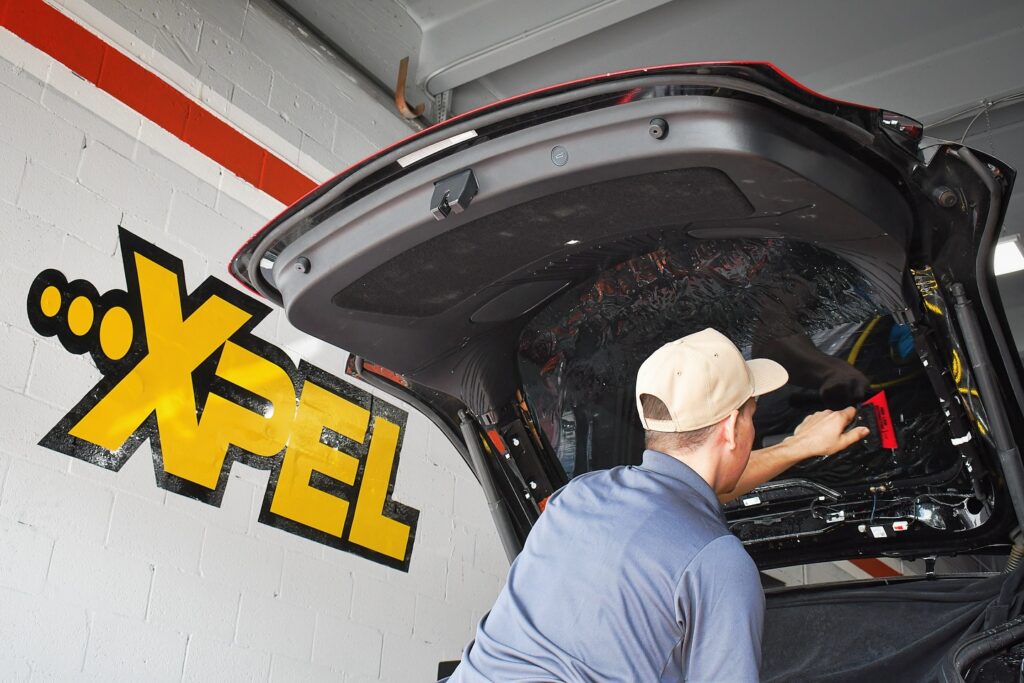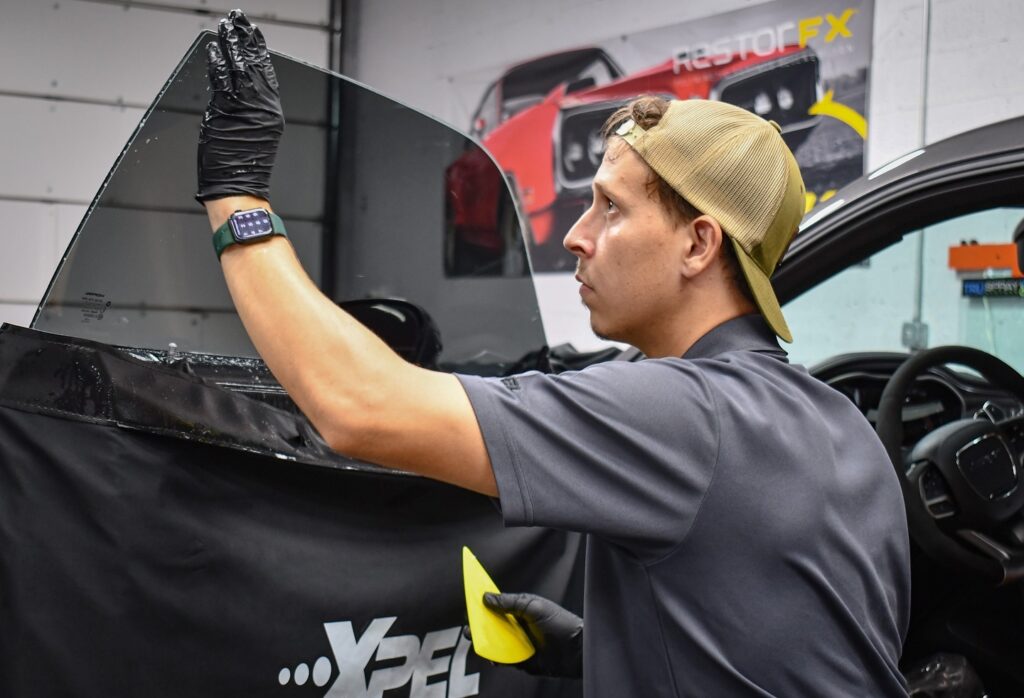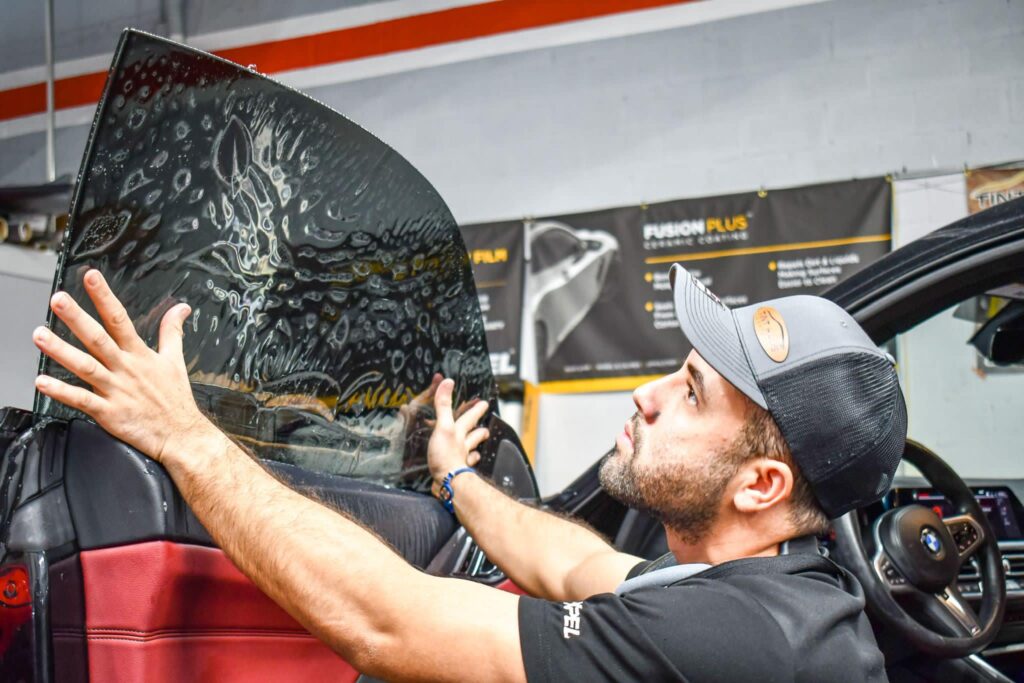Expert Window Tinting Service in South Florida
Welcome to the forefront of vehicular personalization and protection, where our cutting-edge window tinting in South Florida redefines automotive care. Our dedication to innovation means that every vehicle we handle is not only shielded from the relentless sun but also flaunts a sleek, customized appearance that stands out. Whether you’re looking to enhance your privacy, reduce glare, or simply upgrade your car’s aesthetic, our tailored solutions ensure your vehicle is treated with the utmost precision and care.

What is Window Tinting?
Window tinting is the process of applying a thin film to the interior or exterior of a vehicle’s windows. The film is typically made from polyester, dyed with various colors, and coated with adhesive for installation purposes. Window tinting serves several purposes including heat rejection, UV protection, glare reduction, and enhancing privacy.
Benefits of Window Tints
Heat rejection
Window tints block more than 93% to 96% of heat rejection from entering your vehicle, keeping it cool and reducing the need for air conditioning. Ask us about our XPEL Vision line of films for your home of office. Reduce heat while substantially saving energy costs and create additional privacy
UV protection
The sun's UV rays can cause harm not only to your skin but also to your car's interior. Window tints block almost 99% of these harmful rays, keeping your vehicle's interior safe from fading and cracking.
Glare reduction
Window tints reduce glare from the sun and other vehicles, improving visibility and reducing eye strain while driving.
Privacy
Tinted windows provide an added layer of privacy by limiting the view of your vehicle. This is especially beneficial for personal or valuable items left in your car.
Aesthetic enhancement
Window tints can give your vehicle a sleek and stylish appearance, making it stand out from the crowd.

XPEL Ceramic Window Tint
Tint Haus Customs introduces the latest technology in window tinting with XPEL Ceramic Window Tint. This revolutionary product offers unparalleled protection and performance, setting a new standard for automotive window films.
At Tint Haus Customs, we offer several film options, including XPEL CS, XR, and XR Plus, allowing you to choose a customized solution that aligns with your specific preferences. Our team of certified professionals, boasting years of experience, is dedicated to ensuring precise and flawless results in every window tint installation. We take immense pride in delivering top-notch quality window tinting services in South Florida that seamlessly combines style and performance, creating an unparalleled experience for our customers.
We’re not just about standard vehicles; our expertise extends to tinting specialty cars and exotics. Whether you drive a luxury brand like Tesla, BMW, or Mercedes Benz, or a dependable Ford or Chevrolet, our professionals ensure precision and excellence for every application. Each vehicle, regardless of make or model, receives the same attention and care, enhancing both aesthetics and functionality with our tinting services.
Our Application Process
At Tint Haus Customs, we follow a meticulous process to ensure the perfect installation of window tint in your vehicle.

- Consultation: Our team will sit down with you to understand your preferences and goals for tinting your vehicle’s windows. We will then recommend the best film option for your specific needs.
- Preparation: Your vehicle’s interior is thoroughly cleaned, and all areas that will be tinted are prepped for installation.
- Precise Cutting: The window film is cut to precision using state-of-the-art computerized cutting machines, ensuring a perfect fit for your vehicle’s windows.
- Installation: Our certified professionals use advanced techniques to apply the film seamlessly onto your vehicle’s windows, avoiding any bubbles or creases.
- Final Touches: Once the window tint is installed, our team performs a final inspection and makes any necessary adjustments for a flawless finish.
Why Choose Tint Haus Customs?
At Tint Haus Customs, we are dedicated to providing the most innovative and high-quality window tinting service in South Florida. Our commitment to excellence and customer satisfaction is what sets us apart from other tint shops. Here are some reasons why you should choose us for your window tinting needs:

- State-of-the-art technology: We use the latest computerized cutting machines and techniques to ensure precise and flawless window tint installations.
- Certified professionals: Our team of certified professionals has years of experience in tinting all types of vehicles, ensuring top-notch quality in every application.
- Unparalleled customer service: We prioritize our customers’ satisfaction and are committed to providing a seamless and hassle-free experience from consultation to final installation.
- Customized solutions: We offer a variety of film options, including XPEL Ceramic Auto Window Tint, to cater to each customer’s unique preferences and needs.
- Specialization in exotics and specialty cars: Our expertise extends beyond standard vehicles; we specialize in tinting luxury and exotic cars, ensuring precision and excellence in every application.

Ready to give your vehicle the ultimate protection and upgrade its appearance? Visit Tint Haus Customs today for expert Window Tinting in South Florida. Our certified professionals will work with you to find the best solution for your vehicle and ensure a flawless installation. Trust us to take care of your car’s windows and experience the difference XPEL Ceramic Auto Window Tint can make. Learn more about us and book an appointment now to join the growing list of satisfied customers at Tint Haus Customs. We provide services like Paint Protection film and Residential and Commercial Window tinting, aimed at both enhancing and safeguarding your assets. So, don’t wait any longer and give your vehicle the protection it deserves!
